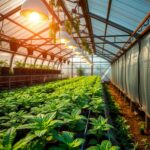Which is Better for a Greenhouse, PVC or Polycarbonate? A Detailed Comparison Guide

When it comes to greenhouse construction, choosing the right glazing material is crucial for maximizing growth potential and ensuring durability. PVC and polycarbonate are two popular options, each with its own advantages and disadvantages. This guide aims to provide a thorough comparison of PVC and polycarbonate, examining factors such as insulation, light transmission, weight, and cost. Whether you're a hobby gardener or a commercial grower, understanding the pros and cons of these materials will help you make an informed decision for your greenhouse project. Dive into this detailed comparison to find out which material truly stands out for your needs.
Which is better for a greenhouse, PVC or polycarbonate?
When it comes to choosing the best material for a greenhouse, polycarbonate often stands out as a superior choice compared to PVC. Although PVC is lighter and cheaper, it tends to be less durable and provides insufficient thermal insulation, which can adversely affect plant growth. On the other hand, polycarbonate is known for its excellent insulating properties and moisture resistance, making it a long-lasting solution for greenhouse construction. Additionally, polycarbonate can withstand harsh weather conditions, including strong winds and hail, and provides better UV protection, contributing to healthier plants inside the greenhouse.
Durability Comparison
When comparing durability, polycarbonate panels are significantly more robust than PVC panels. Polycarbonate can endure extreme weather conditions without cracking or breaking, ensuring the long-term resilience of the greenhouse structure. In contrast, PVC can become brittle over time and may not withstand impacts from hail or heavy snow loads. This makes polycarbonate a safer and more reliable choice for greenhouse applications, especially in regions with unpredictable weather.
Insulation Properties
The insulation properties of polycarbonate are vastly superior to those of PVC. Polycarbonate panels can create an insulated environment that retains heat better, which is crucial for nurturing plants during colder months. This material can have differing thicknesses, allowing greenhouse owners to choose the level of insulation they need. PVC, while it may be less expensive, does not provide the same level of thermal efficiency and can lead to increased heating costs.
Light Transmission
In terms of light transmission, polycarbonate panels excel by providing up to 90% clarity, allowing for optimal sunlight to reach plants. This is essential for photosynthesis and plant growth. PVC, on the other hand, can degrade over time under UV exposure, leading to reduced light transmission and potential harm to plants. Consequently, using polycarbonate can foster a healthier and more productive environment within the greenhouse.
See also:
Cost Considerations
Cost is an important factor when selecting materials; PVC is generally cheaper upfront than polycarbonate. However, considering the long-term benefits that polycarbonate offers, such as durability and energy savings due to better thermal insulation, the initial investment may be justified. While PVC may seem more economical for those on a tight budget, the potential need for repairs or replacements could lead to higher costs over time.
Weight and Installation
Regarding weight and installation, PVC is a lighter material, which can simplify handling and installation for smaller greenhouses. However, this lighter weight also means it’s less stable in stronger weather conditions. Polycarbonate, while generally heavier, provides a more secure structure and can be installed effectively with proper support. Therefore, while PVC may offer ease of installation, polycarbonate’s stability should not be overlooked for long-term greenhouse needs.
| Feature | PVC | Polycarbonate |
|---|---|---|
| Durability | Lower | Higher |
| Insulation | Poor | Excellent |
| Light Transmission | Moderate | High |
| Cost | Lower initial cost | Higher initial cost but more cost-effective long-term |
| Weight | Lighter | Heavier |
Advantages of Polycarbonate Over PVC in Greenhouse Construction
When comparing polycarbonate and PVC for greenhouse construction, polycarbonate often exhibits superior insulation properties, providing better heat retention, which is essential for creating a stable environment for plants. Its durability against impacts and weather resistance far exceeds that of PVC, making it a long-lasting investment. Additionally, polycarbonate offers greater UV protection, shielding plants from harmful sun rays while allowing optimal light penetration. This combination of advantages not only promotes plant health but also contributes to energy savings in heating and cooling costs over time.
Cost Comparison Between PVC and Polycarbonate
The initial cost of PVC is generally lower than that of polycarbonate, making it an attractive option for budget-conscious gardeners. However, when considering the long-term investment and overall lifespan of the materials, polycarbonate tends to provide better value due to its resistance to wear and tear, which can incur costs over time in repairs or replacements.
Heat Retention Capabilities
Heat retention is crucial for greenhouse efficiency, especially during colder months. Polycarbonate panels excel in this area due to their multiple-wall design, which traps air between layers, creating an insulating effect. In contrast, PVC tends to allow more heat escape, leading to potential fluctuations in temperature that could adversely affect plant growth.
See also:
Impact Resistance and Durability
In terms of impact resistance, polycarbonate is significantly stronger compared to PVC, able to withstand harsher weather conditions and potential physical impacts, such as hail or falling branches. This durability ensures that greenhouses made from polycarbonate can endure the rigors of various climates, ultimately leading to fewer repairs and replacements.
UV Protection for Plants
Polycarbonate panels have excellent UV-blocking abilities, which are essential for preventing harmful sun damage to plants while still allowing sufficient light to pass through for photosynthesis. PVC does not offer the same level of UV protection, potentially exposing plants to harmful rays that can stunt growth or distort their development.
Weight and Structural Considerations
When evaluating the weight of greenhouse materials, polycarbonate is lightweight, which can facilitate easier handling and installation. However, its strength allows it to withstand significant loads without compromising structural integrity. Conversely, PVC may appear lighter but lacks the structural strength, which can affect the overall design and stability of the greenhouse, especially in heavy snow or windy conditions.
Questions from Our Readers
Which material is more durable, PVC or polycarbonate?
Polycarbonate is generally considered to be more durable than PVC. It can withstand impacts better and is less prone to cracking, making it a reliable choice for greenhouses exposed to harsh weather conditions.
How do PVC and polycarbonate compare in terms of insulation?
Polycarbonate offers better insulation properties compared to PVC. It has a higher R-value, meaning it retains heat more effectively, which is crucial for maintaining optimal growing conditions in a greenhouse.
See also:
Which material is more cost-effective for building a greenhouse?
While PVC is typically cheaper upfront, polycarbonate can be more cost-effective in the long run due to its durability and better insulation. This could lead to savings in heating and maintenance costs over time.
What are the UV protection features of PVC and polycarbonate?
Polycarbonate usually has built-in UV protection, making it resistant to yellowing and degradation over time. In contrast, PVC can be less effective against UV radiation, which may affect the longevity of the material.

If you want to read more articles like Which is Better for a Greenhouse, PVC or Polycarbonate? A Detailed Comparison Guide, we recommend you check out our Greenhouse category.
Leave a Reply
Related Articles